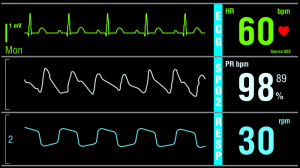by
Lauren Dubinsky, Senior Reporter | May 19, 2016
From the May 2016 issue of HealthCare Business News magazine
Wearable monitoring technology has increasingly become a fixture in health IT headlines, and the number of companies that want to demonstrate the value of their wearables in the clinical setting has also grown. While industry experts readily acknowledge the potential of these solutions to improve care, they generally regard it as a market in its infancy. However, with a few medical-grade wearables like VitalConnect’s VitalPatch and iRhythm’s ZIO XT Patch on the market, there may be a day when patients will no longer be tethered to monitors. But a few technical challenges, such as ensuring the wireless network is reliable, will need to be ironed out first.
While wearables are the flashiest technology on the market, the traditional patient monitors have undergone some significant advancement in recent years. They can be integrated with a hospital’s EMR, monitor end tidal CO2 and be paired with clinical decision support tools to make sure the clinicians get the most useful information.
No strings attached
“I think that the monitoring package will become wireless, will become smaller, will become less of a hindrance to patients, and probably provide more information,” says Dr. Steven Steinhubl, director of digital medicine at Scripps Health. Scripps Health has conducted a number of studies investigating the usefulness of wearables for certain indications. Scripps launched a home-based clinical trial in November that uses the ZIO XT Patch to identify people with asymptomatic atrial fibrillation.
The study will span three years, and so far the researchers have enrolled about 300 participants out of the targeted 2,000. Their goal is to see if they can screen people in the general population without having them come to the hospital.
The ZIO XT Patch is worn as an adhesive patch on the chest and it continuously records heartbeats for up to 14 days. Traditionally, Holter monitors are used for this purpose, which involves wires and ECG leads, and the patient has to wear a box on their belt. “[The ZIO XT Patch] is much easier, much more convenient and [provides much] more information for [the] patient’s heart rhythm,” says Steinhubl.
Wireless wearable sensors made it into ECRI’s Top 10 Hospital C-Suite Watch List for 2016. ECRI thinks that wearables could have real-world benefits in outpatient settings for 24-hour monitoring for chronic conditions like Alzheimer’s disease, diabetes, epilepsy, cardiac arrhythmias, heart failure and pressure ulcer development. ECRI has observed that certain wearable sensors have been approved by third-party insurance companies to replace the Holter monitor for home ECG recording.
